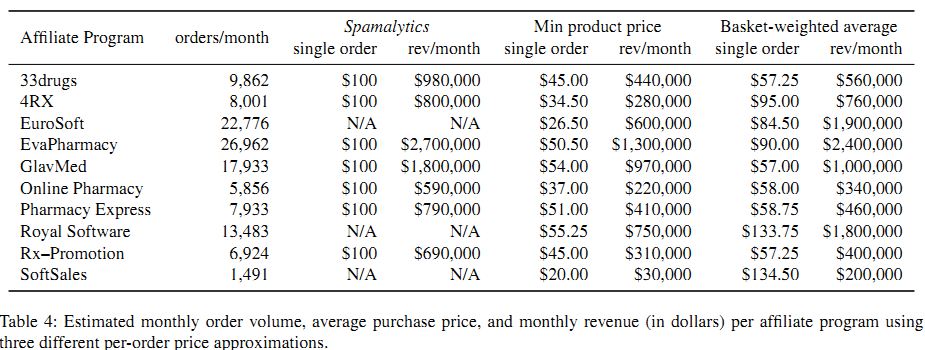Spam may be synonymous with male enhancement drugs, but new research shows that Americans are far more likely than buyers in other countries to turn to spam-advertised pharmacies to obtain pills to treat serious ailments–a trend that reflects differences in government health care and prescription drug policies.
Researchers at the University of California, San Diego, have collected the first data showing which drugs consumers most often buy from spam advertisements, and how much they spend at shadowy online apothecaries.
“People are going to them when they’re either too embarrassed to talk to a doctor, or when it would be far too expensive to buy these drugs otherwise,” said Chris Kanich, a PhD candidate at UCSD’s computer science department, and lead researcher of the study.
Previous estimates of monthly revenue from spam have varied dramatically, from $300,000 to more than $58 million. The UCSD researchers found that the largest rogue Internet pharmacies generate between $1 million and $2.5 million in sales each month, although they caution that their estimates are conservative.
Kanich says the figures show that although the spam-advertised market is substantial, it is not nearly as big as some have claimed, and falls short of annual expenditures on technical anti-spam solutions by corporations and ISPs.
This is an excerpt from a piece I wrote that was published today in MIT Technology Review. Read the full story here. The UCSD paper is available at this link (PDF).





Great reporting, Brian. Well-written article – reading the whole piece was a pleasure. Keep up the good work!
The excerpt says spam revenue “falls short of annual expenditures on technical anti-spam solutions by corporations and ISPs.” Surely corporations block spam more because of the probability of malware?
I don’t know any details about blocking spam. Maybe filtering “legit” spam ads is different than filtering malicious spam?
Jane — Corporations block spam for many reasons, malware being one of them. But also spam is a huge time waster for larger corporations, and can over time decrease employee productivity.
Please, Brian, before someone finds its a good idea to save money, add a warning notice about counterfeit drugs – people could die consuming spamvertised pills cut with strychnine etc. Thx.
WHO, General information on counterfeit medicines:
http://www.who.int/medicines/services/counterfeit/overview/en/
Brian,
I would be interested in knowing exactly which prescription drugs are being bought? Hypertension (hi blood pressure) meds? Diabetes meds? etc.
I think this speaks volumes about the healthcare disparities and the lack of universal health insurance in the USA. I think in this instance, these pharmacies are just making up for the deficits we face here in the USA.
If you had taken the time to read the UCSD paper (link appears above), you would have found lists of the the top product items added to visitor shopping carts and of the top product categories.
There are certainly drugs being purchased in both categories (hypertension and diabetes). The data in the paper documents that ED-related meds dominate, with commonly abused drugs being highly represented (HGH, Soma, Tramadol, etc) as well as weight loss drugs. However, there is certainly a significant fraction that represent the broader spectrum of medical conditions.
Its important to note however that this is a single study, of a single pharmacy, over a short (five day) period of time and one should generalize with caution. Moreover, while differential health-care systems provides one explanation for this aspect of the results there are quite a few other variables that we weren’t able to control for (e.g., impact of differential advertising, price sensitivity of purchasers, etc).
Agree wholeheartedly — when my oldest daughter needed to take an acne prescription last year, the cost WITH “GOOD” insurance for the GENERIC prescription was over $330 a month. I could get the same, name-brand medication from a reputable Canadian pharmacy for $60 but it was legally prohibited and my doctor actually received a written warning not to re-issue the prescription if I didn’t promise to buy from an American pharmacy. My calls to the FDA were frustrating — as far as they know, all generic drugs cost no more than $20. So in my opinion (as a well-educated IT person who made the choice to buy offshore), Americans are more likely to search for alternatives because our healthcare sucks!
“People are going to them when they’re either too embarrassed to talk to a doctor, or when it would be far too expensive to buy these drugs otherwise,” said Chris Kanich…
Mr. Kanich failed to mention the cost of going to see a doctor to even just get a prescription written.
I mean yea, sure, drugs in the U.S. of A. are unnecessarily expensive (because our elected lobbists have decided that WE should pay so that the rest of the world can have cheap drugs derived from the expensive research that WE are effectively underwriting), but the cost of actual health care is even higher. If you ain’t got insurance… and a hell of a lot of Americans still don’t… then it may only cost you $20 for the drug you need, but $75 or more just for a 15 minute visit with a doctor, you know, to get a prescription for it.
(And mind you, doctors aren’t even the biggest part of the health care cost problem in this country. Don’t even get me started about hospitals.)
response to ronbaby:
For some people it’s a lot more than just a $100 to get a perscription or avoiding embarrasment.
For example, the transgender community has special problems getting the drugs they need and they do buy from rogue pharmacies. They appear to feel that the establishment medical world is not helpful.
I do not encourage buying from rogue pharmacies, I think Stefan’s work is top-notch, and I really respect Brian’s work, but there seems to be innocent people that get hurt even when the goal is a good one.